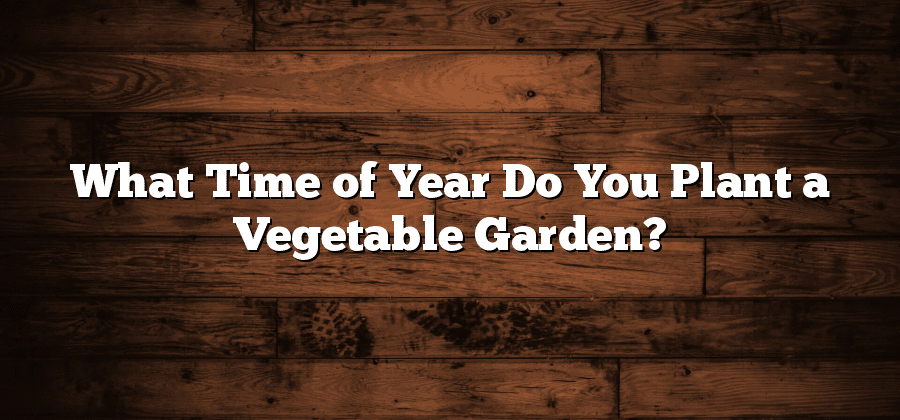Best Time for Planting Vegetable Garden
When it comes to planting a vegetable garden, timing is everything. The success of your garden greatly depends on choosing the best time to get those seeds in the ground. While each region may have its own specific planting calendar, there are some general guidelines that can help you determine the best time for planting.
First and foremost, it’s important to consider your local frost dates. Frost can be detrimental to young seedlings, so it’s crucial to avoid planting too early in the season. Generally, the best time to start your vegetable garden is after the last expected frost date. This will vary depending on your location, but you can usually find this information through your local agricultural extension office or online gardening resources. By waiting until after the last frost, you can ensure that your plants have the best chance of thriving.
Another factor to consider is the temperature of your soil. Seeds need warmth to germinate and grow, so it’s essential that the soil temperature reaches the appropriate range. Different types of vegetables have different soil temperature preferences, so it’s important to know the ideal range for the vegetables you plan to grow. Investing in a soil thermometer can help you accurately monitor the temperature of your soil and ensure that conditions are optimal for planting.
Choosing the right time to plant your vegetable garden is a critical step in ensuring a bountiful harvest. By taking into account the frost dates and soil temperature, you can set your crops up for success. As a dedicated gardener, it’s vital to do your research and plan accordingly to maximize your garden’s potential. Whether you’re a beginner or seasoned gardener, understanding the best time to plant will play a significant role in the overall outcome of your vegetable garden.
Ideal Weather Conditions for Planting
When it comes to planting your vegetable garden, having ideal weather conditions can greatly enhance the success of your yield. The first key factor to consider is the temperature. Most vegetables thrive in temperatures between 55 to 85 degrees Fahrenheit. If the weather is too cold, it can stunt growth and result in poor crop development. On the other hand, excessively hot temperatures can cause plants to bolt or go to seed prematurely.
In addition to temperature, adequate sunlight is a crucial component for successful planting. Vegetables typically require a minimum of six hours of direct sunlight per day. Sunlight is essential for photosynthesis, the process by which plants convert light energy into food. Without enough sunlight, plants may struggle to grow and produce a bountiful harvest. It is important to choose a location for your garden that receives ample sunlight throughout the day.
Overall, planting your vegetable garden in ideal weather conditions, including optimal temperatures and adequate sunlight, lays the foundation for a thriving crop. By paying careful attention to these factors, you can ensure that your plants have the best possible chance of flourishing.
Recommended Soil Temperature for Planting
The temperature of the soil plays a crucial role in the successful growth of vegetables. Each vegetable has its own preferred soil temperature for optimal germination and growth. Understanding the recommended soil temperature for planting can significantly increase your chances of a bountiful harvest.
For most common vegetables, the recommended soil temperature for planting is around 50 to 85 degrees Fahrenheit (10 to 30 degrees Celsius). Seeds planted in colder soils may take longer to germinate, while those planted in warmer soils may have a higher risk of fungal diseases. It is important to monitor the soil temperature and wait until it reaches the ideal range before sowing seeds or transplanting seedlings.
To accurately determine the soil temperature, you can use a soil thermometer. This handy tool allows you to measure the temperature at various depths, ensuring that you have a precise reading. By checking the soil temperature before planting, you can avoid wasting time and effort on seeds that may not thrive in the current conditions. Remember, providing the right soil temperature is a fundamental step towards a successful vegetable garden.
Choosing the Right Vegetables for Each Season
When it comes to choosing the right vegetables for each season, it is important to consider the specific climate and weather conditions of your region. Different vegetables thrive in different seasons, so it is essential to select varieties that are well-suited to the temperatures and conditions of each time of year.
For the spring season, consider planting cool-season vegetables such as lettuce, spinach, and peas. These vegetables can withstand cooler temperatures and will have ample time to grow before the heat of summer sets in. Additionally, root vegetables like carrots and radishes can also be sown during the spring, as they prefer the milder temperatures that this season offers.
Moving into the summer months, it is best to focus on warm-season vegetables that can handle the heat. These include tomatoes, peppers, cucumbers, and beans. These plants not only thrive in warmer temperatures, but they also require longer daylight hours to produce bountiful harvests. Additionally, herbs like basil and parsley can be planted during the summer, as they enjoy the warmth and longer days as well.
Spring Planting for Early Crops
When it comes to spring planting for early crops, timing is crucial. It is important to take advantage of the cooler weather and ample sunlight to ensure a successful harvest. As temperatures start to rise and the soil warms up, certain vegetables thrive during this period, providing an early bounty for your table.
One of the key considerations for spring planting is choosing the right vegetables that can withstand cooler temperatures. Some vegetables that do well in early spring include lettuce, spinach, radishes, and peas. These vegetables are cold-hardy and can tolerate frost, making them ideal for planting as soon as the ground thaws. By selecting these early crops, you can enjoy fresh and flavorful produce while you wait for the warmer months to arrive.






